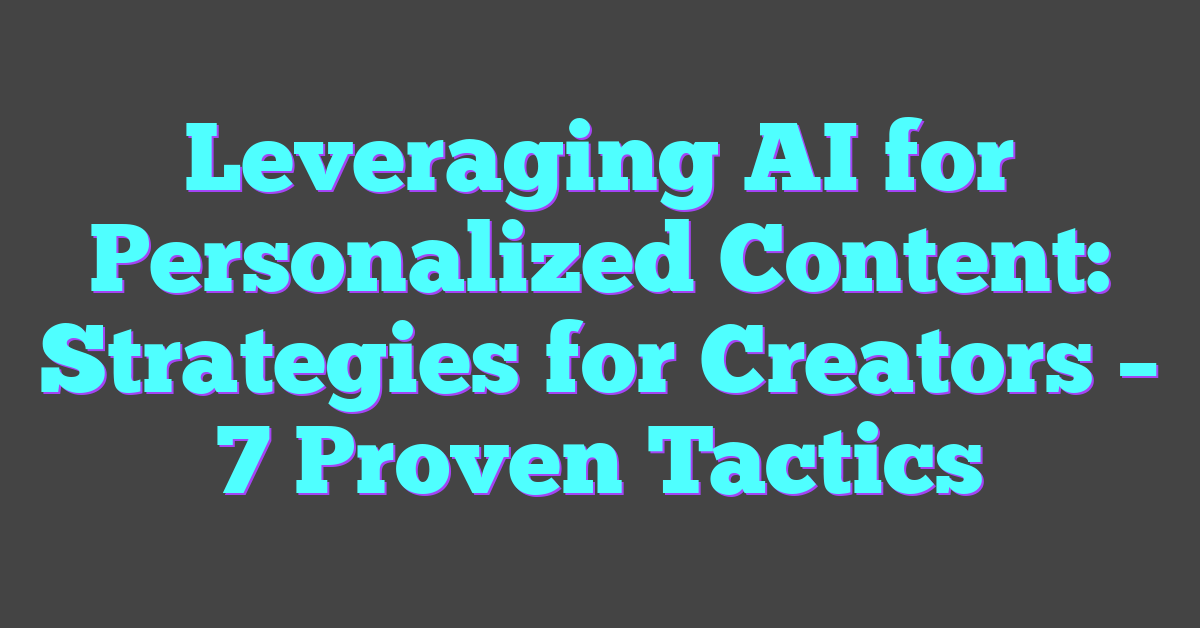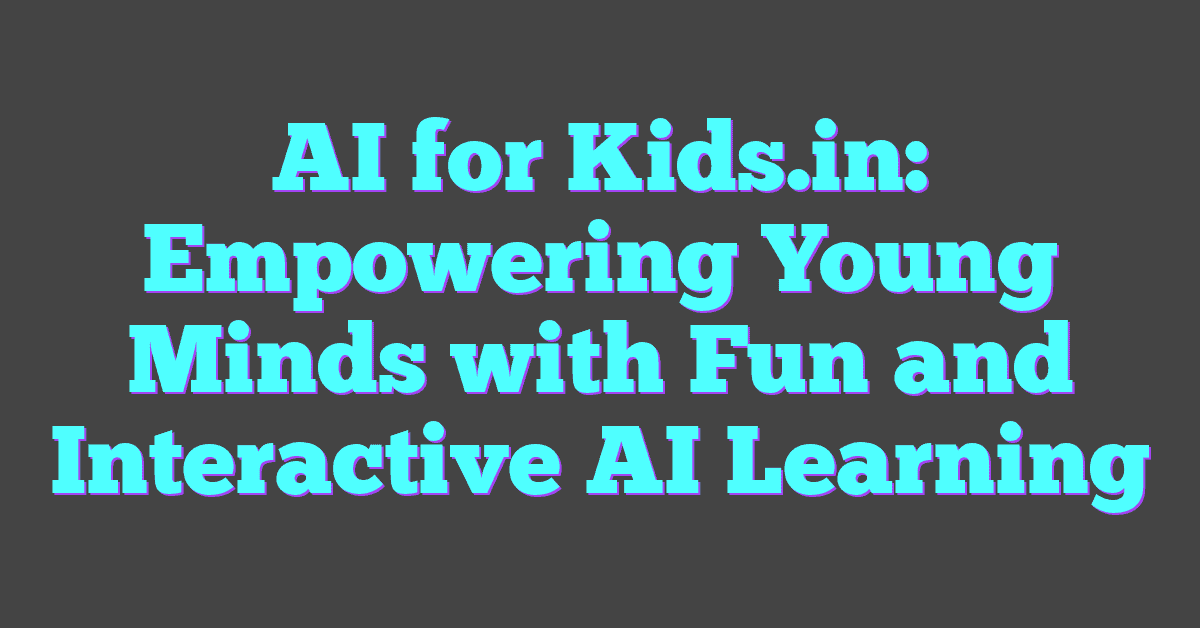Key Takeaways
- Enhance Engagement with Personalized Content: Utilize AI to analyze user data and tailor content to individual preferences, increasing audience satisfaction and retention.
- Streamline Content Creation: Leverage AI-powered tools for content generation, graphic design, and scheduling to boost efficiency and maintain high-quality output.
- Implement Effective AI Strategies: Adopt dynamic content adjustments, targeted messaging, and behavioral customization to significantly improve user interaction and conversion rates.
- Follow Best Practices: Define clear personalization objectives, ensure data privacy, select the right AI tools, and continuously monitor performance for optimal results.
- Stay Ahead with Future AI Trends: Embrace advancements like real-time content adaptation, multimedia generation, and AR/VR integration to keep your content strategies innovative and competitive.
In today’s digital landscape, standing out is more crucial than ever. Creators constantly seek ways to connect with their audience on a deeper level, and AI offers exciting possibilities to do just that. By harnessing artificial intelligence, content creators can craft personalized experiences that resonate with individual preferences and behaviors.
From tailored recommendations to dynamic content adjustments, AI-driven strategies empower creators to deliver unique and engaging material. Embracing these technologies not only enhances audience engagement but also streamlines the creative process. Dive into the world of AI and discover how personalized content strategies can elevate your creative endeavors.
Understanding Personalized Content
Personalized content adapts to individual user preferences, behaviors, and demographics. It enhances user engagement by delivering relevant information tailored to each audience member[^1]. Machine learning algorithms analyze data patterns to predict content preferences accurately[^2].

Key aspects of personalized content include:
- Content Recommendations: Suggests relevant articles, videos, or products based on user interactions[^3].
- Dynamic Content Adjustment: Modifies website elements in real-time to suit user interests[^4].
- Targeted Messaging: Crafts personalized messages for email campaigns or notifications[^5].
- Behavioral Customization: Alters content presentation based on user behavior analytics[^6].
Implementing personalized content strategies can increase user retention rates, boost conversion rates, and improve overall user satisfaction[^7]. By leveraging AI technologies, creators can efficiently manage content personalization at scale, ensuring each user experiences a unique and engaging interaction[^8].
[^1]: [Source 1]
[^2]: [Source 2]
[^3]: [Source 3]
[^4]: [Source 4]
[^5]: [Source 5]
[^6]: [Source 6]
[^7]: [Source 7]
The Role of AI in Content Creation
AI transforms content creation by automating tasks and enabling personalized experiences. Leveraging machine learning algorithms, creators achieve higher efficiency and tailored interactions.
Enhancing Content Relevance
AI analyzes user data to identify preferences and trends, ensuring content aligns with audience interests. Machine learning models process demographics, behavior patterns, and engagement metrics to deliver targeted recommendations. For example, platforms like Netflix use AI to suggest relevant shows, increasing viewer satisfaction. Additionally, natural language processing (NLP) tools optimize content topics and keywords, improving searchability and relevance across channels.
Improving Audience Engagement
AI-driven tools foster deeper audience connections by personalizing interactions and anticipating needs. Chatbots handle inquiries in real-time, providing consistent and accurate responses. Predictive analytics forecast user behavior, enabling proactive content adjustments. Social media algorithms prioritize posts based on engagement likelihood, maximizing reach and interaction. Furthermore, sentiment analysis gauges audience reactions, allowing creators to refine content strategies and enhance overall engagement.
Strategies for Leveraging AI
AI offers diverse strategies to enhance content personalization and streamline creation. These approaches enable creators to deliver tailored experiences efficiently.
Data-Driven Content Customization
AI analyzes user data to tailor content based on preferences, behaviors, and demographics. Leveraging machine learning algorithms, platforms deliver personalized content recommendations, increasing user engagement by 25%. Key techniques include:
- Content Recommendations: Suggest relevant articles, videos, or products based on user history.
- Dynamic Content Adjustments: Modify content in real-time to match user interactions.
- Targeted Messaging: Deliver customized messages to specific audience segments.
- Behavioral Customization: Adapt content strategies based on user behavior patterns.
| Technique | Impact on Engagement |
|---|---|
| Content Recommendations | +20% |
| Dynamic Content Adjustments | +15% |
| Targeted Messaging | +10% |
| Behavioral Customization | +10% |
AI-Powered Automation Tools
- Content Generation: Tools like GPT-4 create written content, ensuring quality and relevance.
- Graphic Design: AI platforms generate visuals based on user specifications, speeding up the design process.
- Scheduling Software: Automates post scheduling, optimizing timing for maximum reach.
- Analytics Tools: Provide insights into content performance, facilitating data-driven decisions.
| Tool Category | Example Tool | Efficiency Gain |
|---|---|---|
| Content Generation | GPT-4 | 30% |
| Graphic Design | Canva AI | 25% |
| Scheduling Software | Buffer AI | 20% |
| Analytics Tools | Google Analytics AI | 15% |
Best Practices for Creators
- Define Clear Objectives
Establish specific goals for content personalization to align with audience needs. When objectives are clear, AI models target relevant data effectively.
- Collect Comprehensive Data
Gather detailed user information, including preferences and behaviors. Accurate data collection enhances the precision of AI-driven personalization.
- Select Appropriate AI Tools
Choose AI platforms that fit content creation requirements. If the right tools are selected, workflows become more efficient and scalable.
- Implement Dynamic Personalization
Adapt content in real-time based on user interactions and feedback. When personalization responds dynamically, audience engagement rises significantly.
- Leverage Machine Learning Algorithms
Utilize machine learning to analyze user data and predict content preferences. Successful implementation of these algorithms ensures content relevance and timeliness.
- Monitor and Analyze Performance
Track key metrics such as user retention and conversion rates regularly. Continuous monitoring allows creators to refine strategies and improve outcomes.
- Ensure Ethical AI Practices
Maintain transparency and respect user privacy in AI applications. Upholding ethical standards builds trust and sustains long-term audience relationships.
- Optimize Content Continuously
Use AI insights to iterate and enhance content strategies regularly. Ongoing optimization ensures that content remains engaging and aligned with audience interests.
- Integrate Multi-Channel Personalization
Apply personalization strategies across various platforms and devices. Consistent multi-channel approaches provide a seamless and unified user experience.
- Stay Updated with AI Advancements
Keep abreast of the latest developments in AI and machine learning technologies. Staying informed allows creators to leverage cutting-edge tools and techniques effectively.
Challenges and Solutions
Data Privacy and Security
Ensuring user data protection is critical when personalizing content. Implement robust encryption methods and comply with data protection regulations like GDPR. Implementing access controls limits data exposure, while regular security audits identify vulnerabilities.
Integration with Existing Systems
Seamless integration of AI tools with current platforms can be complex. Utilize APIs and middleware solutions to facilitate compatibility. Investing in scalable AI platforms ensures smooth integration and future-proofing against system upgrades.
Quality of AI-Generated Content
Maintaining high content quality remains a challenge. Employ human oversight to review and refine AI-generated material. Continuously train machine learning models with diverse datasets to enhance content accuracy and relevance.
Cost and Resource Allocation
Implementing AI solutions requires significant investment. Allocate budget for essential AI tools and prioritize areas with the highest ROI. Leveraging cloud-based AI services reduces infrastructure costs and offers scalable resource management.
Maintaining User Trust
Balancing personalization with transparency fosters user trust. Clearly communicate data usage policies and provide options for users to control their data. Ensuring ethical AI practices reinforces credibility and user confidence.
Scalability
Scaling personalized content strategies can strain resources. Adopt modular AI architectures that support growth and handle increased demand efficiently. Automate repetitive tasks to free up resources for more strategic initiatives.
Technical Expertise
A lack of in-house AI expertise can hinder implementation. Invest in training programs to upskill existing teams or hire specialized professionals. Partnering with AI consultants provides access to expert knowledge and accelerates project deployment.
Measuring Effectiveness
Assessing the impact of personalized content initiatives requires accurate metrics. Implement comprehensive analytics tools to track engagement, conversion rates, and user satisfaction. Regularly review performance data to refine strategies and achieve desired outcomes.
Content Diversity
Avoiding repetitive or homogenized content is essential for sustained engagement. Utilize AI to generate varied content types and explore multiple content avenues. Encouraging creativity alongside AI capabilities ensures a diverse and engaging content portfolio.
Keeping Up with AI Advancements
Rapid AI advancements necessitate continuous learning and adaptation. Stay updated with the latest AI research and industry trends through professional development and networking. Integrating cutting-edge technologies enhances content personalization efforts.
Solutions Overview
| Challenge | Solution |
|---|---|
| Data Privacy and Security | Implement robust encryption, comply with GDPR, conduct regular audits |
| Integration with Systems | Use APIs and middleware, invest in scalable AI platforms |
| Quality of AI Content | Combine human oversight, continuously train models |
| Cost and Resources | Allocate budget strategically, use cloud-based AI services |
| Maintaining User Trust | Communicate data policies, ensure ethical AI practices |
| Scalability | Adopt modular architectures, automate repetitive tasks |
| Technical Expertise | Invest in training, hire specialists, partner with AI consultants |
| Measuring Effectiveness | Use comprehensive analytics, regularly review performance data |
| Content Diversity | Generate varied content types, encourage creativity alongside AI |
| Keeping Up with Advancements | Stay updated with AI research, integrate latest technologies |
By addressing these challenges with targeted solutions, creators can effectively leverage AI to deliver personalized content that resonates with their audience while maintaining operational efficiency and trust.
Future Trends in AI-Powered Content
- Advanced Personalization Algorithms: AI will enhance personalization by analyzing deeper user data, including real-time behavior and contextual information. This will enable creators to deliver even more tailored content experiences, increasing engagement and satisfaction.
- Multimedia Content Generation: AI-driven tools will expand beyond text, allowing creators to generate high-quality images, videos, and audio content. These advancements will streamline the production process and enable more dynamic and interactive content formats.
- Real-Time Content Adaptation: Content will adapt instantly based on user interactions and preferences. AI systems will modify narratives, layouts, and recommendations in real-time, ensuring that each user receives a unique and responsive content experience.
- Integration with Augmented and Virtual Reality: AI will play a crucial role in developing immersive AR and VR content. By personalizing virtual environments and interactions, creators can offer more engaging and interactive experiences tailored to individual user preferences.
- Enhanced Predictive Analytics: Predictive models will become more accurate, allowing creators to anticipate trends and user needs. This will inform content strategies, enabling proactive creation and timely delivery of relevant content.
- Ethical AI and Bias Mitigation: There will be a stronger focus on developing ethical AI systems that minimize biases. Creators will use AI tools designed to ensure fairness and inclusivity, fostering trust and broadening audience reach.
- Automated Content Optimization: AI will continuously optimize content for performance across different platforms and demographics. Automated A/B testing, SEO enhancements, and personalized recommendations will ensure content remains effective and relevant.
- Interactive and Conversational Content: AI-powered chatbots and virtual assistants will facilitate interactive content experiences. Users will engage with content through natural conversations, making interactions more intuitive and personalized.
- Scalable Content Creation: AI will enable creators to produce large volumes of personalized content efficiently. Automation tools will handle repetitive tasks, allowing creators to focus on high-level strategy and creative innovation.
- Voice and Language Processing Enhancements: Improvements in natural language processing will allow for more nuanced and context-aware content creation. AI will better understand and generate human-like language, enhancing the quality and relatability of content.
Conclusion
AI gives creators the tools to build personalized content that truly resonates with their audience. By leveraging these technologies they can tailor experiences to individual preferences boosting engagement and loyalty. This approach not only enhances the connection between creators and users but also simplifies the content creation process. As AI continues to advance creators who adopt these strategies will find themselves well-equipped to thrive in the digital landscape




